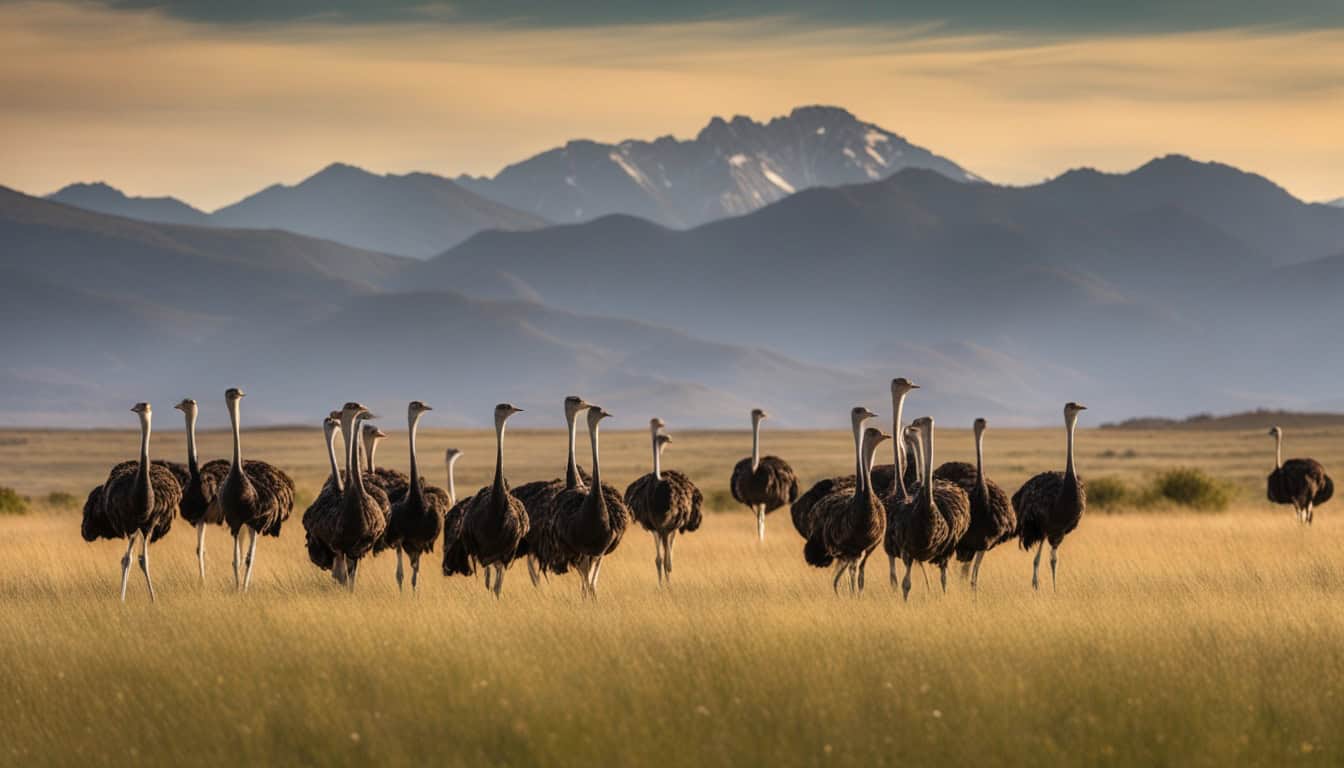The topic of native ostriches in the USA is interesting for bird lovers and researchers. Ostrich species have lived in many parts of the world, each with unique environments. While ostriches are commonly found in Africa and have journeyed to Asia and Arabia, their existence in the USA is less known.
Exploring the history and studying fossil records is crucial to understanding this. This helps scientists learn if USA ever had its own ostrich population. By looking at past data and environmental factors, we can uncover the truth about ostriches in the USA.
Introduction to Ostriches
Ostriches are not like other birds. They are huge and can’t fly. They belong to the genus Struthio. This makes them the biggest and heaviest birds alive today. Because they can’t fly, they focus on running fast. This helps them survive in many places.
What is an Ostrich?
There are two kinds of ostriches we know about today. One is the common ostrich (Struthio camelus). The other is the Somali ostrich (Struthio molybdophanes). They all fall under the Struthio genus. Ostriches stand out for being very large and not being able to fly.
Physical Attributes and Behavior
Ostriches have some amazing features. They are the heaviest birds and can run fast. They weigh between 140-320 pounds. Their strong legs help them run up to 70 km/h to escape danger. They also have interesting ways of mating and living together. These behaviors show their ability to adapt and their special place in nature.
| Number of Species | Common Species | Notable Traits | Speed |
|---|---|---|---|
| 2 | Struthio camelus, Struthio molybdophanes | Largest living birds, flightless birds | Up to 70 km/h |
The Historical Range of Ostriches
Ostriches lived in many places over history, mainly in Africa. They also lived in parts of Asia and the Arabian Peninsula. Knowing where they lived helps us learn about how they’ve changed over time.
Ostriches in Africa
The common ostrich was all over Africa. It lived in places like savannas and desert edges. Its wide presence shows how adaptable it is and how many resources were available.
Ostriches in Asia and Arabia
Ostriches were not just in Africa. Fossils show Asian ostriches were in China and Mongolia. This means ostriches lived in different parts of Asia and the Arabian Peninsula. They were used to many climates and lands.
| Region | Historic Presence | Current Presence |
|---|---|---|
| Africa | Extensive (Common Ostrich) | Widespread |
| Asia | Eastern regions including China, Mongolia | Extinct |
| Arabia | Peninsular regions | Restricted |
Studying the historical range of the common ostrich tells us how they adapted. These researches are key in finding out how they spread and survived in different places.
Are there any native ostriches in the USA?
The topic of native ostriches in North America is very interesting. Modern-day ostriches come from Africa. However, their history shows they were once linked to North America.
Fossil Records and Evolutionary History
Fossils show that ostrich ancestors lived in North America during the Eocene epoch. This discovery tells us that ancient ostriches lived across different lands. They adapted to various environments over millions of years.
Modern-Day Distribution
Today, ostriches are not native to North America. They’re mainly found in Africa. So, there’s no proof that ostriches lived in the USA naturally.
This fact highlights the unique but extinct link ostriches had with North America.
Ostriches Habitat in the United States
Ostriches aren’t native to the U.S. They’ve been brought over for farming and private use. People made setups like the dry African savannas to keep them comfortable, but they aren’t wild here.
Ostriches now live in the U.S. thanks to farms made for them. These places try to be like the birds’ original African homes. However, these American places aren’t the same as wild ostrich populations.
Those who bring ostriches to the U.S. work hard to make sure they’re happy. They manage the environment well, making it a good place for these large birds.
Let’s compare the real and the made ostrich habitats:
| Category | Natural Habitat | Artificial Habitat |
|---|---|---|
| Location | Africa | United States Ostrich Farms |
| Climate | Arid Savannas | Controlled Conditions Mimicking Savannas |
| Maintenance | Self-Sustaining | Human-Managed |
Creating a home for ostriches in the U.S. shows hard work and care. These actions prove that we can make a place for different creatures even in new lands.
American Ostrich Farms: Alternative Livestock
Ostrich farming is a unique addition to American agriculture. It offers both great rewards and big challenges. Raising ostriches in the US is very different from traditional livestock.
Challenges Faced by Farmers
One major challenge is creating the right habitat for ostriches. This includes a lot of space and healthy food. The start-up costs are also significant because it needs special fencing and buildings.
The Market for Ostrich Products
In the USA, the demand for ostrich meat is growing. Many people see it as a healthy choice. The fashion and decor industries also use ostrich feathers and leather. However, success in the market depends on changing consumer tastes.
Below is a table showing primary ostrich products and where they’re mostly sold:
| Product | Primary Market |
|---|---|
| Ostrich Meat | Health-conscious consumers, gourmet restaurants |
| Ostrich Feathers | Fashion industry, home decor, crafts |
| Ostrich Leather | Luxury goods, high-end accessories |
| Eggshells | Decorative arts, collectible items |
The Appeal of Ostrich Farming in the USA
Ostrich farming in the USA is becoming more popular, offering benefits to both farmers and consumers. It brings economic gains and promotes sustainable farming. This trend is rising because of its positive impact.

Benefits for Farmers
Ostrich farming is efficient, leading to higher profits and resource conservation. It costs less to feed them, and their yields are better than other livestock. This means more money for farmers. The birds grow quickly, translating to faster returns.
Additionally, this kind of farming allows farmers to broaden their agriculture. It makes their farms more resistant to changes in the market.
Consumer Interests and Trends
People are more interested in ostrich products because of their health benefits and uniqueness. Ostrich meat is nutritious, lean, and a greener option than beef or pork. The movement for sustainable farming has made eco-friendly consumers choose ostrich products. Ostrich farms contribute to a healthy planet by cultivating native plants, making them more sustainable.
The shift towards sustainable ostrich farming also appeals to those who care about the environment. This all aligns with the growing trend of ethical consumption. It ensures that the products are healthy and made with the Earth in mind.
- Lower feeding costs and higher profitability for farmers
- Consumer preference for healthy and novel meats
- Adoption of sustainable farming practices
| Benefits for Farmers | Consumer Interests | Sustainability |
|---|---|---|
| Lower Costs | Healthier Meat | Native Plant Cultivation |
| High Yield Rates | Novelty Factor | Minimized Environmental Impact |
| Diversification | Ethical Consumption | Eco-conscious Practices |
Comparing Ostriches to Other Flightless Birds
Flightless birds, like ostriches, emus, and rheas, are part of the same group in the bird family. Yet, they look and live very differently. When we look at ostrich vs other flightless birds, we see unique features and homes.
Ostriches live in Africa. They are the biggest and heaviest birds, with males reaching up to 9 feet tall. In comparison, emus are from Australia and are a bit smaller but strong, reaching about 6 feet. Rheas come from South America and stand at about 5 feet, showing their toughness too.
Each bird has traits that help them live in their specific places. Ostriches, for instance, have very long and strong legs. These legs are perfect for the vast savannas they call home. They can run as fast as 45 mph. Emus also have strong legs suited for Australia’s bushes, but they can run slightly slower, up to 30 mph. Rheas have different legs for the South American plains, not as fast, but very strong for their needs.
The ways they look are also quite distinct. Ostriches have big eyes and long necks. This lets them see far away from danger. Emus, on the other hand, have small heads relative to their bodies. They are well-camouflaged in their bushy homeland thanks to dense feathers. Rheas, with their gray-brown feathers, can easily hide in the grasslands where they live.
But, there are things that make them alike, too. They all are very caring parents. Males are usually the ones to build nests and raise their chicks. Also, their food is similar. They eat plants, bugs, and sometimes small animals – they are omnivores.
| Characteristic | Ostrich | Emu | Rhea |
|---|---|---|---|
| Habitat | Africa | Australia | South America |
| Height | Up to 9 feet | Up to 6 feet | Up to 5 feet |
| Speed | Up to 45 mph | Up to 30 mph | Up to 25 mph |
| Feather Structure | Sparse, flight-oriented | Thick, bush-ready | Gray-brown, camouflaging |
Conservation and Environmental Impact
Ostrich farming is expanding and raising concerns about its impact on the environment. Conservation efforts in ostrich farming focus on practices that are good for both the farmers and the planet.
Erosion Control and Native Plants
Using the right plants plays a big part in managing an ostrich farm. Native plants in ostrich areas help prevent soil erosion. They keep the soil in place and add to the local plant and animal life. This means the area is more likely to take care of itself.
Carbon Sequestration and Sustainability
One farm’s carbon footprint is also important. Ostrich farms can help in the fight against climate change by capturing carbon. Trees and plants on these farms pull carbon from the air. This reduces the farm’s impact on the climate and moves it toward a sustainable future.
These practices aim to keep ostrich farms from harming the environment. They help the farms do well with a light impact on the planet, showing farming can be nature-friendly. This is good for the future of both farms and the earth.
Future of Ostrich Populations in North America
The future of ostrich populations in North America depends on several things. These include the ongoing interest in farming them, the rules in place, and how much we work to conserve them. With more people wanting to try exotic foods and support sustainable farming, the market for ostrich products might grow a lot. This could encourage more farmers to get into ostrich farming, which has benefits for both the environment and the economy.
Technology in farming is also key for the future of ostriches. New methods in breeding, managing where they live, and keeping them healthy can make ostrich farming better. These advances mean lower costs and more efficiency. This makes it a smart choice for people in the U.S. who want to farm.
Wildlife conservation is important for ostriches too. It’s vital that we keep biodiversity and manage ecosystems as we farm ostriches. This helps prevent harm to local wildlife. Using native plants and ways to prevent erosion on ostrich farms help keep the local plants and animals safe. It creates a balance between farming and the natural world.
FAQ
Are there any native ostriches in the USA?
No, there are no native ostriches in the USA. Fossil records show ostrich relatives lived across the globe, even in North America, long ago. But, today, ostriches only live in Africa.
What is an ostrich?
An ostrich is a big bird that can’t fly. They are the biggest birds on Earth and can run up to 70 km/h.
What are the physical attributes and behaviors of ostriches?
Ostriches have big bodies, long necks, and strong legs. They dance and run in unique ways. Even though they can’t fly, they can run really fast.
What regions have ostriches historically occupied?
Ostriches have mainly lived in Africa throughout history. They also used to live in places like the Arabian Peninsula. Fossils suggest they were in parts of Asia too, such as China and Mongolia.
Do ostriches have a natural range in North America?
No, ostriches don’t naturally live in North America. While their relatives did in the past, today’s ostriches are only in Africa.
Are there wild ostrich populations in the USA?
No, there are no wild ostriches in the USA. Any ostriches in the country are on farms or in private places, not in the wild.
What is the habitat of ostriches in the United States?
In the United States, ostriches usually live on farms or with private owners. The places they live try to be like their natural African homes. But, these settings are man-made and not natural.
What are the challenges faced by American ostrich farmers?
Ostrich farmers in America have many challenges. They need to create special habitats for their birds. They also find it hard to predict when exactly the market will want ostrich products. Plus, keeping the big birds is not cheap.
What is the market for ostrich products like in the USA?
In the USA, the market for ostrich goods is growing. People are interested in ostrich meat, feathers, and leather for their health and eco-friendly features.
What are the benefits of ostrich farming in the USA?
Raising ostriches in the USA has many pluses. It costs less than traditional farming, plus the meat is good for you. This kind of farming is better for the environment too.
How do ostriches compare to other flightless birds?
Ostriches are unique among other birds that can’t fly. They are different in size, looks, and how they act. All these birds have a common family history but have adapted differently to their homes.
How do ostrich farms contribute to conservation and environmental sustainability?
Ostrich farms can help nature by doing a few things. They plant local plants, stop soil from washing away, and create homes for some local animals. Also, these farms can trap carbon from the air which is good for the planet.
What is the future of ostrich populations in North America?
The future for ostriches in North America depends on a few things. The interest in farming them, new farming tech, and what people like to eat are important. How their farming supports nature and the laws about it are also key.







